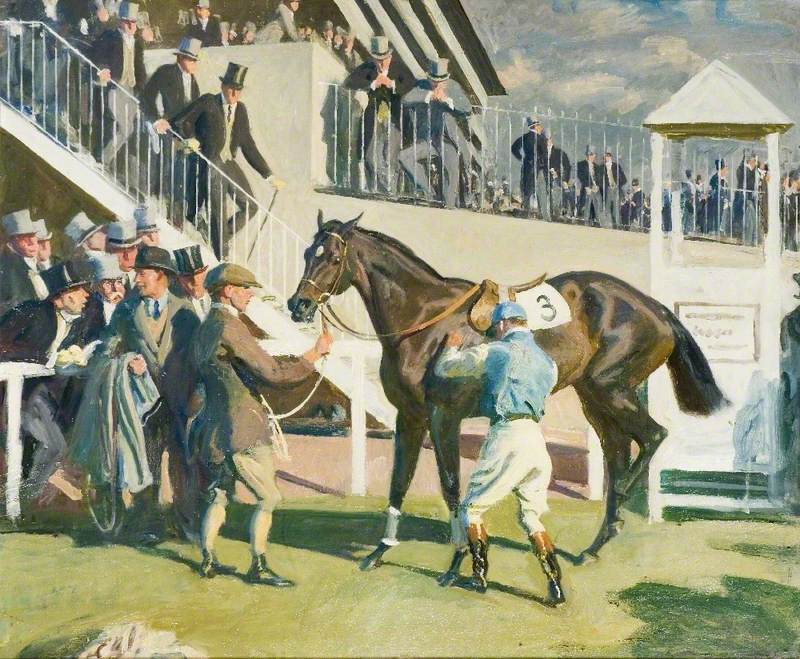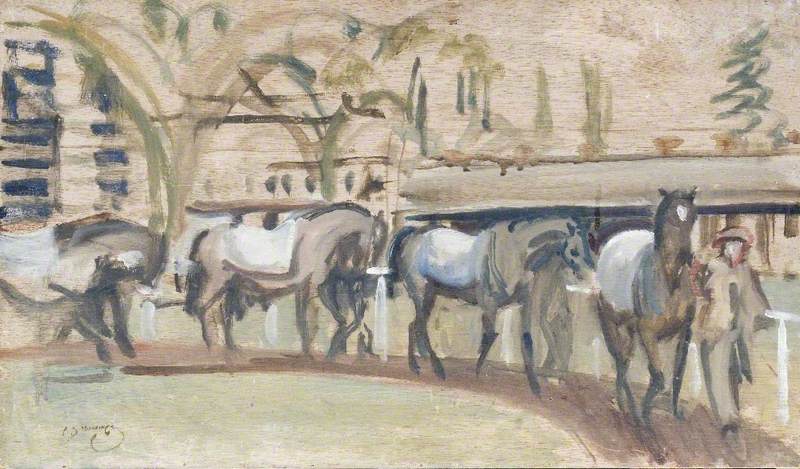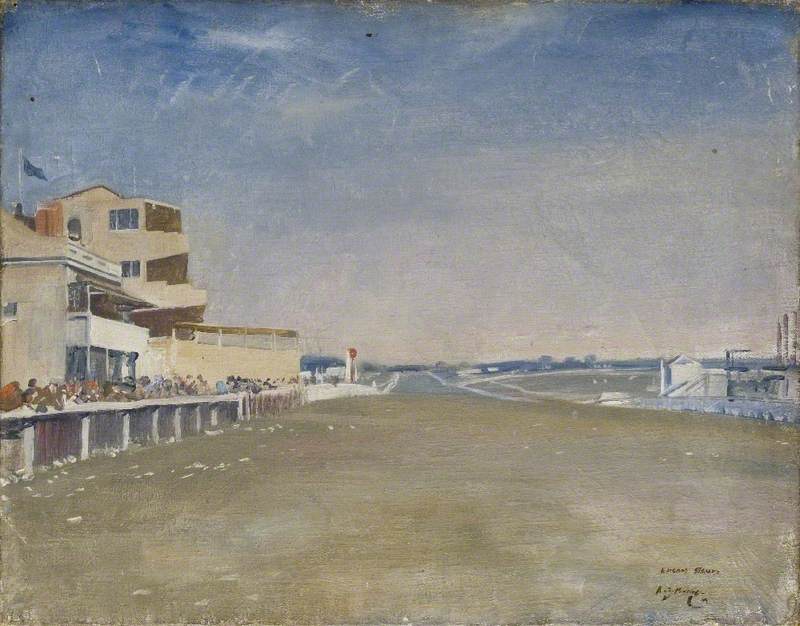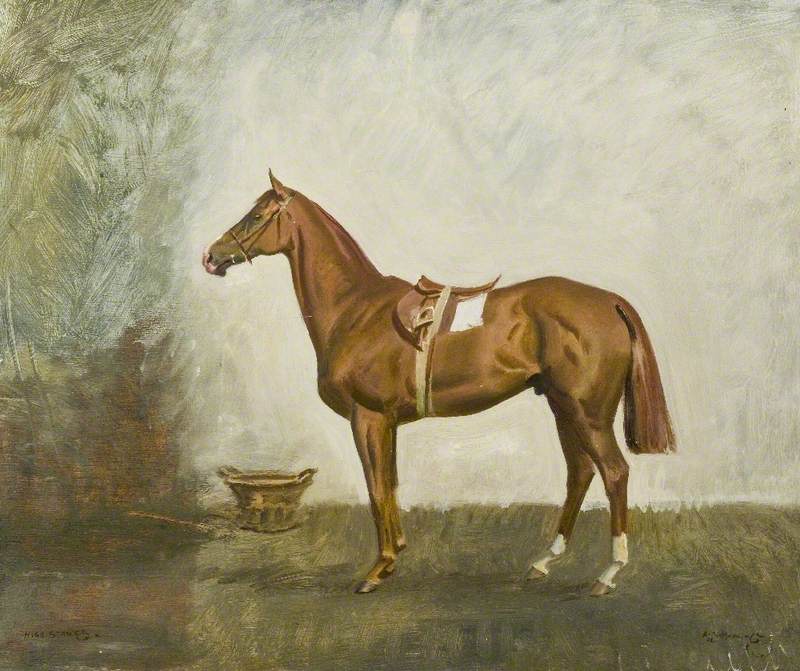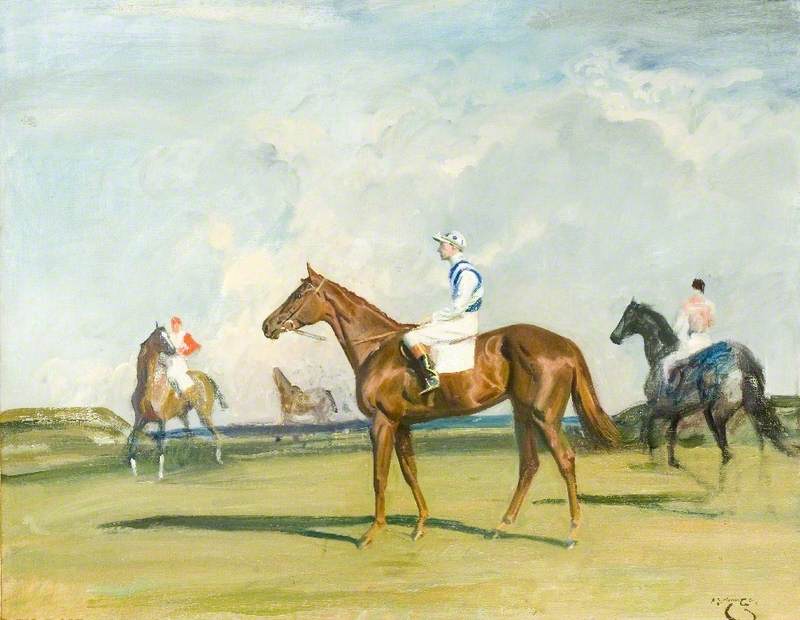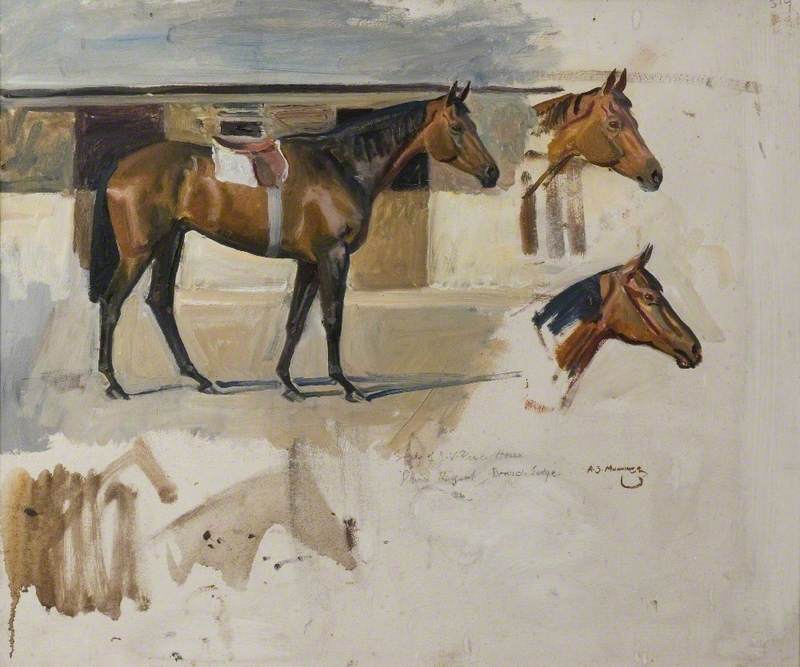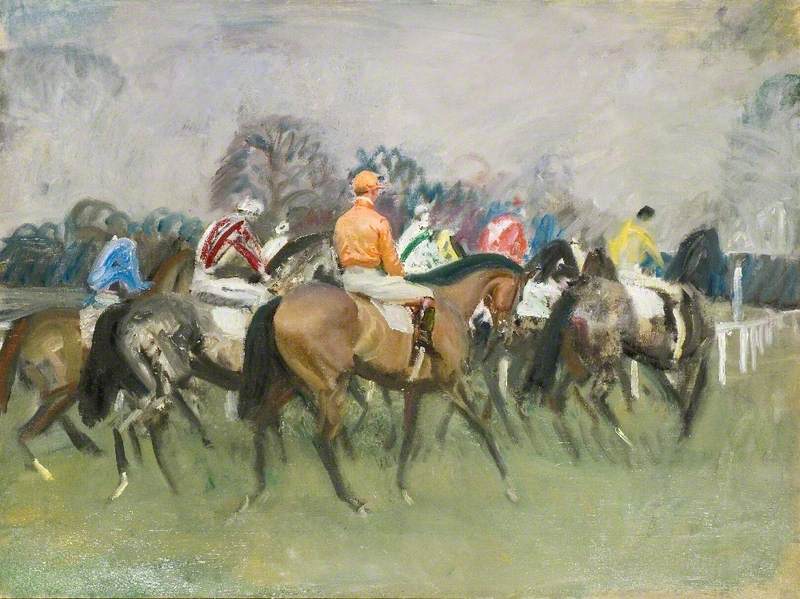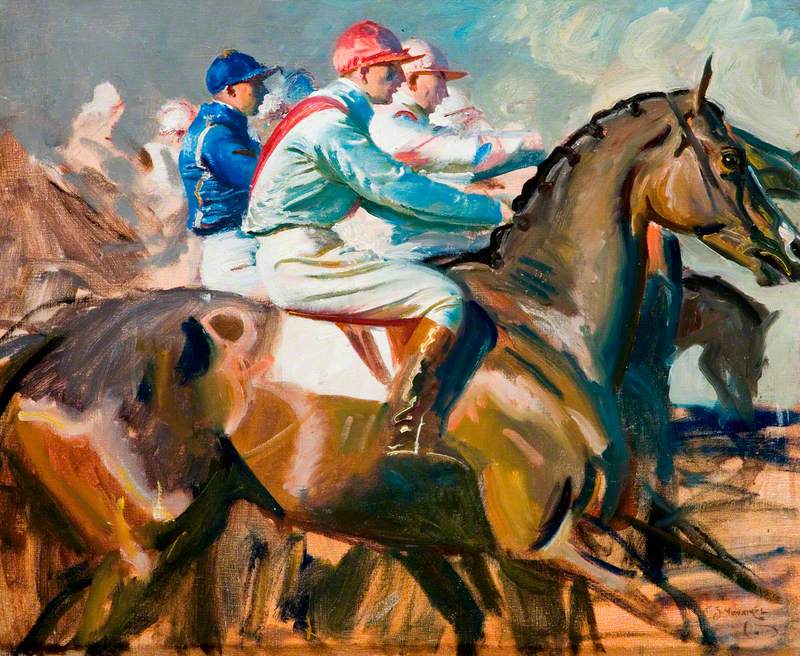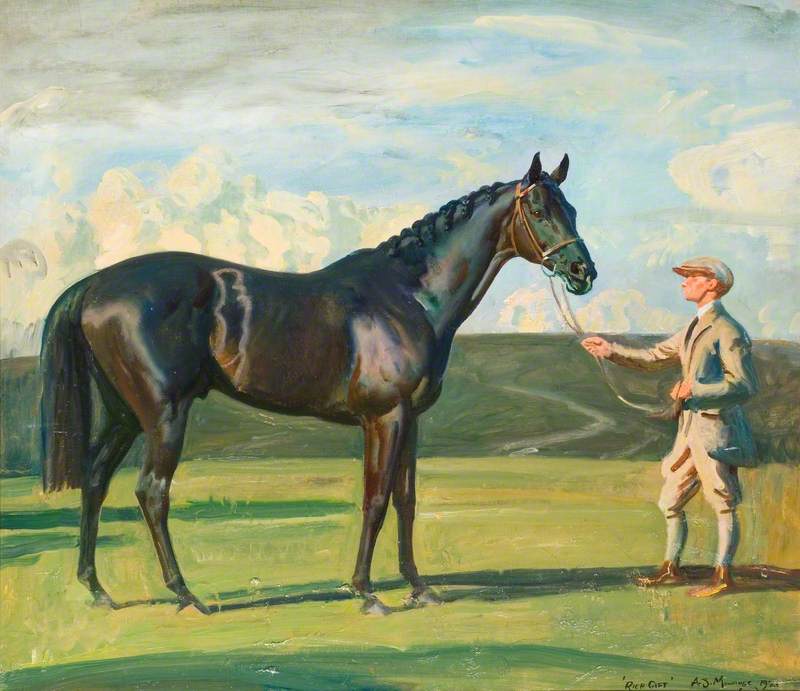Sir Alfred Munnings made clear of his passion for horse racing,
“I do love racing. I love the interest created as the horses are led around after saddling up…I love the sight of the members’ stand, from the roar ‘They’re off!’, to the terrific finish.”
It was after the First World War that Munnings began painting commissions of thoroughbred racehorses and racing scenes.
In this curation, by Curatorial Associate Dr Bill Teatheredge, explore racing studies and finished oil paintings by Sir Alfred Munnings.
-
The Unsaddling Enclosure, Epsom
The Unsaddling Enclosure, Epsom 1948Many sketches and studies would go in to the preparatory work for this painting.
‘There is a certain depth and transparency in a well-groomed coat of a horse...There is nothing opaque about it...On the surface of a live animal...there are high lights, when we grasp the meaning of these high lights it becomes interesting. On browns the lights are cooler, greyer-bluer...on a bay, less cool; on a chestnut inclining to pinky-grey. On a well-grown horse in the sun these lights are devastating.’
Alfred James Munnings (1878–1959)
Oil on canvas
H 63.5 x W 76.2 cm
The Munnings Art Museum
-
Study of Horses in Kempton Paddock
Study of Horses in Kempton PaddockMunnings was an expert in drawing or painting the form of a horse.
Standing by the side of a paddock he would quickly sketch the scene which he would later work up to a study and finished piece.
Alfred James Munnings (1878–1959)
Oil on board
H 35.6 x W 61 cm
The Munnings Art Museum
-
Before the Race
Before the RaceEven in the most basic study Munnings had the ability to bring the scene to life.
Here in the paddock at Cheltenham a trainer and jockey talk tactics.
Alfred James Munnings (1878–1959)
Oil on canvas
H 50.8 x W 76.2 cm
The Munnings Art Museum
-
Study of a Horse and Jockey
Study of a Horse and Jockey 1948A favourite board or canvas size which Munnings used throughout his career was 20 x 24’’, 51 x 61 cm.
In this study of an unsaddling enclosure the jockey is the focal point of Munnings composition.
Alfred James Munnings (1878–1959)
Oil on board
H 50.8 x W 61 cm
The Munnings Art Museum
-
The Epsom Stand
The Epsom StandThe attention to detail and the lengths Munnings would go in order to perfect his subject matter are demonstrated in his paintings of Epsom in 1931.
Three paintings, ‘The Saddling Paddock’, ‘Going Out’ and ‘Unsaddling’ were completed after months of work following the Epsom weeks in 1929 and 1930.
This study of the Epsom Stand was one of Munnings preparatory works for this project.
Alfred James Munnings (1878–1959)
Oil on canvas
H 55.9 x W 71.1 cm
The Munnings Art Museum
-
Horses with Stable Lads up at Newmarket
Horses with Stable Lads up at NewmarketWith his decision not to do any more commissions Munnings depictions of race horses changed. Newmarket became a second home, especially with the Jockey Club giving Munnings the use of the old rubbing house, near Devil’s Dyke, as a studio.
Now he was painting for his own enjoyment where his use of impressionistic effects would return to his art. One of his favourite sights was watching the horses at exercise.
Alfred James Munnings (1878–1959)
Oil on board
H 45.1 x W 74.3 cm
The Munnings Art Museum
-
Under Starter's Orders, Newmarket Start, Cries of 'No, No, Sir'
Under Starter's Orders, Newmarket Start, Cries of 'No, No, Sir' 1957Being at the side of the track at Newmarket painting the start of the brought Munnings great enjoyment.
In this large painting he is trying to animate the work where the horse’s legs create a sense of movement. With horse number 13 Munnings has painted in the region of 7 front legs which adds to the illusion.
Alfred James Munnings (1878–1959)
Oil on canvas
H 112.4 x W 177.8 cm
The Munnings Art Museum
-
'High Stakes', Lord Astor's Horse
'High Stakes', Lord Astor's Horse 1951Lord Waldorf Astor was one of Munnings more frequent patrons. Munnings had the use of the old rubbing-stable, near Devil’s Dyke, as a studio and it was here that he was to paint one ‘... last picture’ of a racehorse.
This work is one of the studies which Munnings produced, taking him many days to complete and he considered it to be a faithful portrait. The attention to the detail of the central subject is contrasted by the background which is very loosely rendered with strident brush strokes.
Alfred James Munnings (1878–1959)
Oil on panel
H 50.8 x W 61 cm
The Munnings Art Museum
-
'Happy Laughter', a Chestnut Racehorse, with Jockey up in a Landscape
'Happy Laughter', a Chestnut Racehorse, with Jockey up in a Landscape 1954Although a study this painting highlights Munnings’ supreme skill at painting a race horse. The central figure of Happy Laughter has a sheen and muscle definition that is second to none.
Alfred James Munnings (1878–1959)
Oil on canvas
H 72.3 x W 91.4 cm
The Munnings Art Museum
-
Study of J. B. Rank's Horse, 'Prince Regent', Druids' Lodge
Study of J. B. Rank's Horse, 'Prince Regent', Druids' Lodge 1949Munnings was commissioned by J.V Rank on many occasions to paint his horses at Druids Lodge stables including, in 1949, to paint Prince Regent the winner of the 1942 Irish Grand National.
Attention to detail and the horse’s character is emphasised in the studies of Prince Regents head.
Alfred James Munnings (1878–1959)
Oil on board
H 50.8 x W 61 cm
The Munnings Art Museum
-
Moving up to the Start
Moving up to the Start 1955Although the start of a race came to define Munnings’ paintings of horseracing he would also paint events prior to the race such as the saddling enclosure or the horses making their way to the start.
Moving up to the Start is a study or unfinished painting made towards the end of Munnings’ life. Here he uses more technical skills where perspective is created by the use of a receding serpentine line, which runs through the flanks of the horses and away with the rails of the fence. Further depth is achieved by the shortening tree line, from right to left.
Alfred James Munnings (1878–1959)
Oil on canvas
H 88.9 x W 119.4 cm
The Munnings Art Museum
-
Under Starter's Orders
Under Starter's Orders‘Each start was a fresh picture for me, as they have been, meeting after meeting, year after year.’
The start of a race with the colours of the silks, the noise and anticipation was always a very special subject for Munnings.
Alfred James Munnings (1878–1959)
Oil on canvas
H 50.8 x W 63.5 cm
The Munnings Art Museum
-
Coming off the Heath, Exercising the Horses, Newmarket
Coming off the Heath, Exercising the Horses, Newmarket 1947Enjoying the spectacle of the horses being exercised also highlights the more bizarre medium Munnings would work with. In this case wardrobe doors.
‘There was other work at Newmarket. Filling pages of notebooks at the canters on Warren Hill before and after breakfast. I began each afternoon-with the scene fresh in mind-setting out ideas on three six-foot panels: doors of an old wardrobe from Lady Ludlow's house by the plantations at the top of Warren Hill. These excellent doors were discovered in the premises of a painter and decorator in Newmarket. Hanging one of the panels on a shady wall in a friend's garden behind his house, I worked in the most perfect light.’
Alfred James Munnings (1878–1959)
Oil on board
H 58.4 x W 182.9 cm
The Munnings Art Museum
-
Study for 'Rich Gift'
Study for 'Rich Gift'In painting this work Munnings explained how he began by imagining the finished piece.
“Again I begin in my mind, mixing the rich, dark, bluey tones of the quarters, back and shoulders-painting the turn of the neck-always so difficult-the three-quarter view of the head, the perspective across the forehead.”
Alfred James Munnings (1878–1959)
Oil on canvas
H 66 x W 76.2 cm
The Munnings Art Museum
